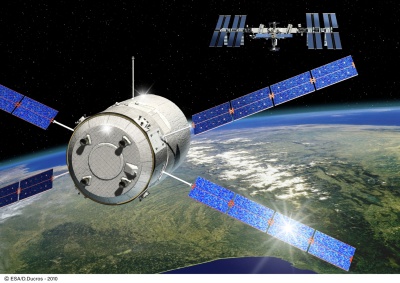If you wish to contribute or participate in the discussions about articles you are invited to contact the Editor
Satellite Realtime Navigation
| Applications | |
|---|---|
| Title | Satellite Realtime Navigation |
| Edited by | GMV |
| Level | Intermediate |
| Year of Publication | 2011 |
From the very beginning it was realized that GNSS systems could also be used for a wide range of scientific and other civil applications. New tracking methods that were not foreseen by the original developers of the systems, like carrier tracking, were proposed and, as soon as it was possible, successfully tested and used. One of the applications that was soon envisioned was the use of GPS for navigation of spacecraft. The first onboard receiver was installed and flown in a Landsat satellite even before the complete GPS constellation was deployed. Since that time, more receivers have been flown on satellites, at first as a demonstration of increasingly precise uses and now as the main operational means of navigation[1].
Application Architecture
For Satellite Realtime Navigation it is not usually possible to rely on post-processing algorithms and ground based station networks. For Low Earth Orbit spacecrafts kinematic point position solutions present a similar accuracy as terrestrial applications[2]. This accuracy can be improved by using algorithms that incorporate a dynamic model of the spacecraft's orbit.
Attitude Control
GNSS receivers can be used also for attitude control and determination in a similar way as for aviation attitude determination. For space applications typically 2 different setups can be used[2]:
- Multiantenna platforms - That use carrier-phase interferometry.
- Single antenna - Using variation of received signal power.
Application Characterization
Currently kinematic Point Position solutions can achieve a navigation accuracy of 10 m and 0.1 m/s for GNSS receivers on Low Earth Orbit without further optimizations. This level of navigation accuracy is considered adequate for attitude and orbit control systems[3]. Meter level accuracy can be achieved using onboard Kalman filters and algorithms that take into account the dynamic model of the orbit.
Experiments with the Proba-2 satellite show that 1-2 m positioning accuracy could be achieved using onboard advanced real-time navigation filters[4].
For attitude determination, GNSS has been used mostly as a course sensor providing enough accuracy for some applications. But for applications that require high accuracy attitude determination, other types of attitude sensors such as star trackers are preferred. Despite this the GNSS information, when available, is normally integrated with the other sensor data in the Attitude and Orbit control subsystem (AOCS) of the spacecraft and contributes to the attitude determination and attitude control of the spacecraft.
Application Examples
- ATV - Automated Transfer Vehicle - Expendable, unmanned resupply spacecraft developed by the European Space Agency[5]. GPS and a star tracker is used to automatically rendezvous with the International Space Station and at a distance of 249 m, the ATV computers use videometer and telegoniometer data for final approach and docking manoeuvres[6].
- Proba-2 - The Proba satellites are part of ESA’s In-orbit Technology Demonstration Programme, missions dedicated to the demonstration of innovative technologies[7]. Proba-2 incorporates two experimental GPS receivers for demonstration of Satellite Realtime Navigation and Precise Orbit Determination[4].
Notes
References
- ^ Satellite Navigation Using GPS, T.J. Martín Mur & J.M. Dow, ESA Bulletin Nr. 90, May 1997
- ^ a b GNSS Applications and Methods - Chapter 13 - Space Applications, E. Gleen Lightsey, Artech House
- ^ Real-Time Onboard Navigation, DLR
- ^ a b Laser tag caps Proba-2’s technology-testing year, ESA Portal, November 2010
- ^ Automated Transfer Vehicle, ESA Portal, March 2011
- ^ ATV flight phases, ESA Portal, March 2011
- ^ About Proba-2, ESA Portal, November 2010

